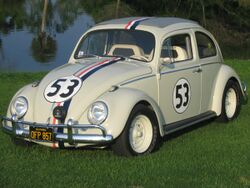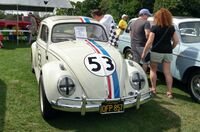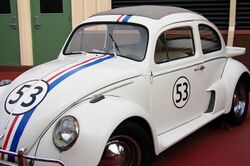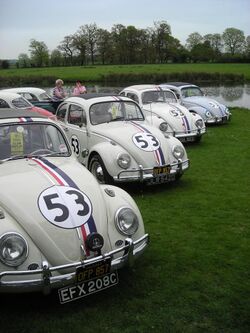Engineering:Herbie (Disney character)
| Herbie | |
|---|---|
 An original Herbie used by Disney for the filming of Herbie Goes to Monte Carlo | |
| First appearance | Script error: No such module "Formatted appearance". |
| Last appearance | Script error: No such module "Formatted appearance". |
| Make/Model | Volkswagen Beetle |
| Information | |
| Full name | Herbie the Love Bug |
| Gender | Male |
| Occupation | Racing car |
| Nationality | German American |
Herbie the Love Bug (commonly referred to simply as "Herbie") is a fictional sentient anthropomorphic 1963 Volkswagen Beetle, a character that is featured in several Walt Disney motion pictures starting with the 1968 feature film The Love Bug. He has a mind of his own and is capable of driving himself, and is often a serious contender in auto racing competitions. Throughout most of the franchise, Herbie is distinguished by red, white and blue racing stripes from front to back bumper, a racing-style number 53 on the front luggage compartment lid, doors, and engine lid, and a yellow-on-black '63 California license plate with the registration "OFP 857".
History
This section describes a work or element of fiction in a primarily in-universe style. (January 2019) (Learn how and when to remove this template message) |
Herbie's origins as a racing car are firmly established in The Love Bug (1968). Before the events of the film, he was bought from the showroom of Peter Thorndyke (David Tomlinson) by San Francisco socialite Mrs. Van Luit for her upstairs maid, but returned him shortly afterwards due to reliability problems. He was then purchased by race driver Jim Douglas (Dean Jones), who had earlier stood up for Herbie when Thorndyke kicked him. Tennessee Steinmetz (Buddy Hackett), Jim's best friend and housemate, names the car "Herbie" after his uncle Herb, a middleweight boxer whose nose got shaped more and more like a Volkswagen Beetle, then makes Herbie a racing car.
In Herbie Rides Again (1974), Herbie has been left to Tennessee's widowed aunt, Mrs. Steinmetz (Helen Hayes). Mrs. Steinmetz and her displaced neighbor, Nicole Harris (Stefanie Powers), try to save her house from being bulldozed by Alonzo Hawk (Keenan Wynn) with the help of Herbie. During the film, it is explained that after several successful races with Herbie, Douglas entered foreign racing circuits while his sidekick Tennessee is residing in Tibet to help his ailing instructor. During the film, it is revealed that Herbie has befriended other sentinent VW Beetles and these team up with him to defeat Hawk, and we learn of the existence of other sentient objects (briefly mentioned by Tennessee in the first film), such as Mrs. Steinmetz's self-playing jukebox.
By Herbie Goes to Monte Carlo (1977), Douglas enters Herbie in the Trans-France Race and recruits mechanic friend Wheely Applegate (Don Knotts) to assist him. Herbie falls in love with a Lancia Montecarlo named Giselle (who is also alive) and Douglas with her driver Diane Darcy (Julie Sommars). Herbie also finds himself in the wrong place at the wrong time when the stolen Etoile de Joie diamond is hidden in his gas tank.
In Herbie Goes Bananas (1980), Douglas has retired from racing after Monte Carlo and leaves Herbie to his nephew, Pete Stancheck (Stephen W. Burns), who plans to enter Herbie in the Brazil Grand Primeo. In the interim, Herbie befriends an orphan named Paco (Joaquin Garay, III), with whom he wreaks havoc with onboard the cruise ship the Sun Princess, prompting the overzealous Captain Blythe (Harvey Korman) to force Herbie to "walk the plank". Having fallen into the ocean, Herbie is rescued by Paco and disguised as a taxi, later to stop a gang of con artists from stealing ancient Inca gold. Early in their partnership, Paco gives Herbie the nickname "Ocho" because he can't understand Herbie talking through his horn. Ocho is the Spanish word for the number 8; purportedly because the digits 5 and 3 in Herbie's racing number, 53, were combined to produce "8" (5+3 = 8) and possibly to rhyme with "Vocho", the Beetle's colloquial name in Mexico.
After the Mexico debacle, Douglas takes in Herbie and opens a driving school in the TV series Herbie, the Love Bug. There, Douglas meets a woman named Susan MacLane and her three kids: Julie, Matthew, and Robbie, with the kids become friends to Herbie, But; however, a business man named Randy Bigelow want to get rid of Herbie and Douglas and get Susan back after they broke up during his wedding.
Hank Cooper (Bruce Campbell) becomes the owner of Herbie in the 1997 made-for-television movie The Love Bug. Here, Herbie's origins as a sentient Volkswagen Beetle are explained: an elderly German engineer named Dr. Gustav Stumpfel was building Herbie when a picture of his deceased wife fell into a vat of molten metal; with Stumpfel's love for her animating Herbie. During the film, Stumpfel is forced to build an evil Volkswagen counterpart to Herbie, "Horace the Hate Bug", from a sample of Herbie's original metal. Horace's personality is influenced by the narcissism of Herbie's former owner Simon when he has a picture of himself dropped into the metal vats, and kills Herbie during the film. Cooper buries Herbie, but the return of Jim Douglas sets Cooper to rebuild the fallen Love Bug (with the help of the repentant Dr. Stumpfel) and have him race against Simon and Horace. In this race, Herbie ultimately divides himself in half (as in the original film) to win the race.
Over the years Herbie is passed down from owner to owner (including someone named "Maxx", who left his driver suit inside the hood), competing in many races, until he starts losing constantly to newer and faster cars, and later found by a tow truck driver in a garage and carried to Crazy Dave's scrapyard and, later, bought by Maggie Peyton (Lindsay Lohan) in Herbie: Fully Loaded (2005). He is later modified, becoming a 2002-cc-engined car and participating in various races, from a demolition derby to the final race of the Nextel Cup Series. Herbie eventually falls in love with a Volkswagen New Beetle (which, at the end, is revealed to be a sentient car too).
Appearance in media
Herbie has been the central character of five theatrical-release films, a made-for-TV movie, and a short-lived television series.
Film series
| Occupation | Film | |||||
|---|---|---|---|---|---|---|
| The Love Bug (1968) |
Herbie Rides Again (1974) |
Herbie Goes to Monte Carlo (1977) |
Herbie Goes Bananas (1980) |
The Love Bug (1997) |
Herbie: Fully Loaded (2005) | |
| Director | Robert Stevenson | Vincent McEveety | Peyton Reed | Angela Robinson | ||
| Producer(s) | Bill Walsh | Ron W. Miller | Kevin Corcoran Ron Miller Don Tait |
Joan Van Horn Irwin Marcus |
Robert Simonds | |
| Writer(s) | Screenplay by Bill Walsh Don DaGradi Story by Gordon Buford |
Screenplay by Bill Walsh Story by Gordon Buford |
Arthur Alsberg Don Nelson |
Don Tait | Ryan Rowe | Screenplay by Thomas Lennon Robert Ben Garant Alfred Gough Miles Millar Story by Thomas Lennon Robert Ben Garant Mark Perez |
| Composer | George Bruns | Frank De Vol | Shirley Walker | Mark Mothersbaugh | ||
| Cinematography | Edward Colman | Frank Phillips | Leonard J. South | Frank Phillips | Russ Alsobrook | Greg Gardiner |
| Editor(s) | Cotton Warburton | Gordon D. Brenner | Chip Masamitsu | Wendy Greene Bricmont | ||
| Production company | Walt Disney Productions | Walt Disney Television | Walt Disney Pictures Robert Simonds Productions | |||
| Distribution | Buena Vista Distribution | Buena Vista Television | Buena Vista Pictures | |||
| Runtime | 108 minutes | 88 minutes | 104 minutes | 98 minutes | 88 minutes | 101 minutes |
| Release date | December 24, 1968 | June 6, 1974 | June 24, 1977 | June 25, 1980 | November 30, 1997 | June 22, 2005 |
Box office performance
| Film | Release date | Box office gross (as of 2017)[1] | Rotten Tomatoes | ||
|---|---|---|---|---|---|
| Domestic | Domestic adjusted | Worldwide | |||
| The Love Bug | 1968 (limited) 1969 |
$51,264,000 | $312,277,200 | N/A | 75% |
| Herbie Rides Again | 1974 | $38,229,000 | $176,834,700 | N/A | 80% |
| Herbie Goes to Monte Carlo | 1977 | $29,000,000 | $111,721,400 | N/A | 67% |
| Herbie Goes Bananas | 1980 | $18,000,000 | $57,776,900 | N/A | 40% |
| The Love Bug | 1997 | — TV film — | 51% | ||
| Herbie: Fully Loaded | 2005 | $66,023,816 | $89,096,100 | $144,146,816 | 41% |
| Total | $205,516,816 | $747,706,300 | $280,639,816+ | 59% | |
Television series
A television series, Herbie, the Love Bug or Herbie the Matchmaker,[2] was aired in 1982 on CBS. Dean Jones reprised his role as Jim Douglas for the series.[3] Five episodes were made.[4]
Other appearances
- In 1990, Herbie made an appearance in the second season of the 1980s revival of the Mickey Mouse Club.
- An animated version of Herbie made a brief cameo in two episodes of House of Mouse.
- Two racing video games were released by Disney Interactive Studios: Disney's Herbie (2005) and Disney's Herbie: Rescue Rally (2007).
- Herbie used to make an appearance in the Lights, Motors, Action! Extreme Stunt Show at Disney theme parks, but was later replaced by Lightning McQueen.
- Herbie has had numerous appearances in Disney parades, and has taken part in Disney on Ice, and Disney on Parade, usually in the latter two with painted-on eyes and teeth, along with a moving tongue. This Herbie model has been moved to Disney's All-Star Movies Resort in Walt Disney World and is the centrepiece of 'The Love Bug' themed area.
- Herbie has an unofficial appearance along with Maggie Peyton (portrayed by "Fully Loaded" actor Breckin Meyer) in a segment of Robot Chicken titled Horny Robot Redux. In the segment, he is a New Beetle rather than an original Beetle and has animated eyes and a mouth.
- Herbie has a brief cameo in an episode of American Dad!, where he helps Stan Smith escape from poachers and wolves. In the episode, he has incorrect stripes and different 53 font.
- The Herbie film series spawned a knockoff series of Superbug films. A white Beetle, split in half and numbered 53, makes a cameo in the first film of the series, though its name is never mentioned.
- Herbie had a cameo in The Simpsons episode Beyond Blunderdome in the Movie Car Museum.
- Herbie makes an appearance in ‘’Forza’’ as a paint job for the 1960s Beetle
- Herbie appears in a Disneyland's 50th Anniversary TV commercial where he is used for transportation by Mickey and Goofy to get to Disneyland.
Guises and paint schemes
Herbie's appearance remained consistent throughout the first four film entries as well as the 1982 television series (Herbie the Matchmaker). There were only minor, subtle changes. The 1997 TV movie and Herbie: Fully Loaded featured major overhauls in Herbie's appearance, as there were different production crews working for Disney by this time.
In order to create the effect of Herbie driving himself, Disney concocted a detailed system of sprockets and pulleys connected to a second steering column under the front seat for a rear seat driver. There was also a second set of pedal assemblies, clutch cables and a shifter extension. In The Love Bug, the rear seat driver sat low enough to see over the windshield but still out of the view of the camera. For Herbie Rides Again and Herbie Goes to Monte Carlo, Disney installed a hood-mounted Carello fog light that concealed a small camera which allowed the rear seat driver to view the street and sit lower.[5]
The Love Bug (1968)
In the original film, The Love Bug, the original racing stripes differ from those in later movies; the stripes do not cover the valances or louvers of the car and the blue is a lighter shade. Also, Herbie features color-keyed running boards, while in later films the running boards are standard black.[6]
During the film, depending on the scene, the wheels change from standard VW wheels (although fitted with plain hubcaps with no VW logo) to specially widened wheels on the racing Herbies. During one scene (when Tennessee is hanging out of the window), the "53" logo (a.k.a. "gumball") on the passenger-side door is missing. The door is also cut along the lower edge at an angle to enable the car to tilt over to the right on two wheels.[6]
One of the modified racing Herbies featured a Porsche 356 engine, brakes and KONI shock absorbers. All Herbies in The Love Bug had the VW badges removed from the hood and featured plain non-VW hubcaps. The hood-mounted VW logo was replaced with a plain disc of the same diameter, colored to match the body. All VWs logos were removed to avoid any trademark conflicts.[6]
Herbie Rides Again (1974)
In Herbie Rides Again, Herbie features revised racing stripes, with the original blue switched to a dark navy. In addition, the stripes were applied over the valances and louvers, and the front hood was recycled for 1982's television series Herbie the Matchmaker. Herbie also received a hood-mounted Carello fog light, and his running boards were now the more conventional black.[6]
Additionally, Herbie was running on standard wheels yet again. Volkswagen also promoted the film by having a Type 1 Beetle, complete with Herbie livery, in every showroom. There are various model errors in this film, such as the later "big window" (post-1964) Beetles being used. Also of note is the "cut-n-shut" engine cover after the warehouse break-in. The Beetle used was a late model, having a more bulbous flat-bottomed lid with an earlier rounded bottom edge welded on.
After the success of The Love Bug, the film was heavily endorsed by Volkswagen, which was in financial trouble at the time, when Beetle sales in North America were considerably lower than in previous decades. As such, the company insisted that the VW logos appear on Herbie. Both the hub cap VW logo and hood-mounted VW logo were reinstated at the company's request.
Herbie Goes to Monte Carlo (1977)
In Herbie Goes to Monte Carlo, Herbie is again fitted with wide racing wheels (Goodyear GT radials), and has an external fuel filler cap. Post-1967 Beetles did feature the fuel tank accessible on the right side behind the fender; the silver cap itself, however, was fake and added for the film's storyline.[7] With the addition of the fuel filler, the antenna is now a retractable unit fitted on the front cowling, near the windshield wipers. He has a roll cage again, and he has Monte Carlo racing stickers on his windows (one on the front window, two on the left back window, and one on the rear window). Herbie still sports the hood-mounted Carello fog light with an added black cover sporting the company name. He now has gray bucket seats instead of stitched seats. Throughout this film, Herbie has an asymmetrical door mirror. There were a total of 9 VWs used in Herbie Goes to Monte Carlo. Many of these cars were recycled for use in Herbie Goes Bananas.[6]
Herbie Goes Bananas (1980)
In Herbie Goes Bananas, the hood-mounted light, the grey roll cage bar, the Monte Carlo racing stickers and the silver gas cap were removed. He still had his gray bucket seats, asymmetrical door mirror and his Goodyear GT Radial racing tires and rims, and Herbie's sunroof was the original light gray rather than the dark gray from Monte Carlo. The rust seen on the car in this film was painted on some of the Herbies. The car that "walks the plank" in the movie was never recovered from the sea. It was tossed overboard from the "M.N. Coromuel" ferry ship (not The Sun Princess cruise ship). The car is somewhere between La Paz and Baja California. The car thrown overboard was not a proper car and had many wooden parts.
Herbie Goes Bananas also featured the same later model door mirror as Herbie Goes to Monte Carlo. Herbie set a Guinness World Record as the first car to go through the Panama Canal during filming in 1979. Herbie's name is only mentioned 3 times in the film by the garage owner, apart from the two times Herbie honks his horn at Paco trying to say his name when Paco couldn't understand what Herbie was saying.
Some of these Herbie cars were recycled for Herbie, the Love Bug in 1982.
One of the actual film cars used with its flip wheel chassis in the bullfighting scenes now resides in Sydney, Australia. Another one was displayed in the Cars of the Stars Motor Museum until the museum's closure in 2011. Since then its new location remains unknown.
Volkswagen ceased the sale of Beetles in the USA one year before the film's release.
The Love Bug (1997)
In the television film, The Love Bug, there were some significant changes. The graphics used were copied from the 1974 Volkswagen of America decal kit, and the position on the front hood 53 was higher up. The racing stripes were different sizes, and the shade of blue reverted to the lighter version used in the original 1968 movie. The sunroof was a solid white (vs. gray) and was missing the racing stripes. Herbie's wheels were standard Beetle wheels, instead of the wider GoodYear GT Radial racing tires used in Herbie Goes to Monte Carlo and Herbie Goes Bananas, and the seats were regular instead of the gray bucket seats he had previously had.
Herbie: Fully Loaded (2005)
In Herbie: Fully Loaded, Herbie, who in this film seemed to be able to show emotions miming a face, went through several "costume changes" throughout the movie, changing his style dramatically from scene to scene.
- The font of the 53 is different, and it is slightly bigger and lower down on the front hood. The racing stripe is missing from the sunroof and the stripes are painted the way they were in the first four Herbie movies. Herbie's front licence plate is not present on his front bumper anymore.
- For the "street racer" look, Herbie has brighter white paint, a whale-tail rear spoiler, air intakes in the front of the rear fenders, lowered suspension, wider tires and a windowed rear engine cover through which blue LED lighting shows. He is also shown to have a nitrous oxide system to boost his speed during the race against Trip Murphy.
- During the demolition derby, Herbie is stripped down with no interior panels, racing seats or special body parts. The sunroof cover has been removed, although the cutout remains to play important roles during the demolition derby. He still retains the same 53 logos on the sides that he wore in his street race look and the white paint and all modifications in his Street Version were dismantled and thrown away for good. He later gets red Bull's-eye targets spray-painted on his front doors and hood by Crash.
- For the "NASCAR" look, Herbie gets a new, more off-white paint job, NASCAR sponsor decals, a different duck-tail rear spoiler, a roll cage, Goodyear Eagle NASCAR tires, wider fenders, and no front turn signals or a back bumper or a passenger seat and back seat.
More than 30 different Herbies were used during the shooting of this film.[6] One is on display at the Volo Auto Museum[8] and another one used during the NASCAR racing segment of the film is preserved at the Peterson Automotive Museum.[9]
References
- ↑ "Franchises: Herbie the Love Bug". http://www.boxofficemojo.com/franchises/chart/?id=lovebug.htm. Retrieved December 5, 2015.
- ↑ "Herbie, the Love Bug" (1982) on IMDb
- ↑ The Complete Directory to Prime Time Network and Cable TV Shows 1946-Present. Ballantine Books. 2003. p. 523. ISBN 0-345-45542-8.
- ↑ "Herbie, the Love Bug (TV Series 1982– )". https://www.imdb.com/title/tt0083428/episodes.
- ↑ "LoveBugFans.com - The Ultimate Herbie Community". http://lovebugfans.net/faq.htm.
- ↑ 6.0 6.1 6.2 6.3 6.4 6.5 "Lovebugfans.com - The Disney Cars". October 28, 2009. Archived from the original on October 28, 2009. https://web.archive.org/web/20091028040125/http://www.geocities.com/lovebugfans/moviecars/index.htm.
- ↑ "The VW Beetle -- Changes Through the Years". http://www.vw-resource.com/years.html#1961-1970.
- ↑ "Volo Auto Museum Cars for Sale - Herbie Fully Loaded". Volocars.com. Archived from the original on January 24, 2013. https://web.archive.org/web/20130124031128/http://www.volocars.com/rental_detailed.php?cid=954. Retrieved January 1, 2013.
- ↑ "Petersen Automotive Museum: The Vault". Petersen.org. Archived from the original on March 17, 2013. https://web.archive.org/web/20130317041825/http://www.petersen.org/exhibitions/the-vault. Retrieved January 1, 2013.
it:Un maggiolino tutto matto





